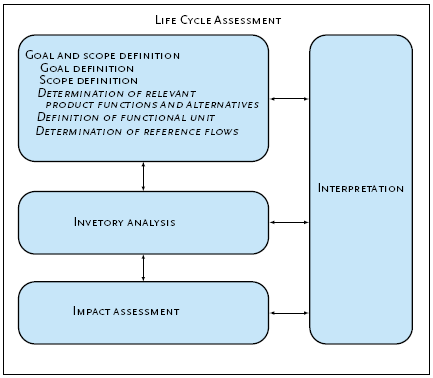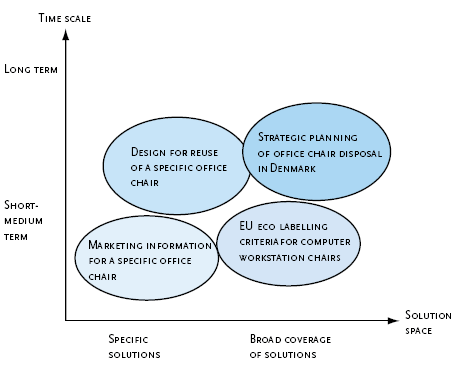|
| Front page | | Contents | | Previous | | Next |
The Product, Functional Unit and Reference Flows in LCA
2. Introduction
2.1 Definitions and purpose
Product substitutions
Products play a key role in the attempts to reduce the total environmental impact of human activities. This is because every human activity - and consequently its impacts on the
environment – can be related to specific needs and the fulfilment of these needs by material or non-material products. Different products, causing different environmental impacts, may
fulfil the same need. Thus, environmental impacts may be reduced by substituting between products. The purpose of life cycle assessments is to assess the possible environmental
impacts of such product substitutions, i.e. the choice of one product instead of another (or the choice of a specific product instead of refraining from this product).
Product functions
All products are produced to perform one or more functions, providing one or more services, fulfilling one or more customer requirements. For example, the function of an office chair
can be expressed in terms of "seating support for one computer workstation for one year" with some additional minimum requirements with respect to durability, strength, stability, safety
and comfort, including adjustments of seat and backrest, arm rests etc.
Different functions are relevant in different contexts
For a specific life cycle study, the different product functions and ways of fulfilling them are not all of equal relevance. Therefore, as part of defining the scope of the study it is crucial to
determine the studied functions, the relevant alternative solutions to fulfil these functions, and to ensure the equivalence of the compared alternatives.
Some important definitions are:
Definitions
A functional unit is a quantified description of the performance of the product systems, for use as a reference unit. Example: Lighting 10 square metres with 3000 lux for 50000 hours
with daylight spectrum at 5600 K.
A reference flow is a quantified amount of product(s), including product parts, necessary for a specific product system to deliver
the performance described by the functional unit. Example: 15 daylight bulbs of 10000 lumen with a lifetime of 10000 hours. The reference flow is the starting point for building a model
of the product system.
Further definitions of important terms used in this document can be found in Annex 1.
The place in an LCA
The issues dealt with in this guideline (the determination of relevant product functions and product alternatives, the definition of the functional unit, and the determination of the reference
flows) are part of the scope definition of a life cycle assessment. Thus, they are some of the first elements in a life cycle assessment, typically following immediately after the definition of
the goal of the study as seen in Figure 2.
Figure 2.
The position of the issues of this guideline in the overall framework of a product life cycle assessment

The purpose within the LCA
Three different purposes are thereby served:
- To determine the object of study, thereby providing a first delimitation of the product systems to be studied.
- To provide a quantified reference unit for all other data in the study.
- To determine the reference flows that provide equivalence between the alternative product systems in a comparative study.
These three purposes are reflected in the step-wise procedure, described in Chapter 3.
The purpose of this guideline
The purpose of this guideline is to provide an unambiguous procedure, based on an identification and analysis of the conditions of the market segment in which the analysed products are
to be sold. The aim of the procedure is to minimise the arbitrariness in performing this crucial phase of life cycle assessments.
2.2 Relation to different applications of life cycle assessment
In general, applications of life cycle assessments differ in two dimensions:
- with regard to the time horizon of the study (short/medium or long term as determined by the period for which the conclusions of the life cycle study should be valid, plus the duration
of the consequences of the possible decision on the affected processes), and
- with regard to how specific the object of study is defined (a specific product for a specific market or a group of products aimed at several markets).
This gives four possible application areas, differing with respect to the product functions and product alternatives to be covered, see Table 2.
Differences between applications are due to differences in the affected markets
In all situations, the coverage is determined by those functions of the product, which are (expected to be) required in the market segment, in which the product is to be sold. Thus,
differences between application areas are due to differences between the affected markets. This is further elaborated in Chapter 3.
Table 2.
Main categories of application areas, illustrated by four examples. These four examples (also shown in Figure 3) will be used throughout this guideline
| Coverage of solution spaceTime horizon |
Specific solutions(relatively specific definition of the product be to studied) |
Broad coverage of solutions(broader definition ofthe object of study) |
| Short tomedium term |
Typically: Enterprise internal studies aimed at supporting choice of suppliers
or marketing claims
The goal of such studieswill be very narrowlydefined in relation to the existing
products of the enterprise
Example: information on a specific chair |
Typically: Studies aimedat defining ecolabellingcriteria for a product group
Covering representativeproducts in the relevant market segment
Example: Marketing EU eco-labelling criteria forcomputer workstation chairs |
| Long term |
Typically: for product development
The goal of such studiesis still linked to the specificinterests of an enterprise,but
due to the longertime horizon, it mustcover a wider range of development alternatives
Example: Design for reuse of a specific chair |
Typically: Studies aimed at supporting societal action plans and legislation
Such studies covernot only representative products in a market, but also future
changes in the market as well as the potential products in this market
Example: Strategic planningof office chair disposal in Denmark. |
Figure 3.
The four examples in relation to the application areas.

Despite the differences in coverage shown in Table 2, it is still the same procedure, which should be used to determine the product functions, the studied product alternatives, the
functional unit, and the reference flows, independently of the application area.
The procedure itself is independent of application areas...
...but the procedure may be followed less stringently under some conditions
However, the procedure may be followed less stringently if the studied product substitution involves only products with identical properties, e.g. when the difference between the
products is only relating to modification of some production processes which do not affect the properties of the product as such. As there are no performance differences between the
analysed product systems, all steps except step 4 (see Chapter 3) can be dealt with more quickly or even skipped altogether. The same is true when looking exclusively at one specific
product compared to refraining from this product.
Also, for enterprise specific studies, step 3 in the procedure, the determination of the relevant product alternatives (Section 3.1.3), may be dealt with less stringently, in that the enterprise
has a large degree of freedom to define what it regards as relevant alternatives. Nevertheless, even enterprise internal studies should seek to reflect the actual consequences of the
decision to be supported, and should therefore include the product alternatives, which are expected to be affected by the decision, which typically means the products that are (expected
to be) available on the relevant market.
Iteration of the procedure
Although the procedure in Chapter 3 is described as five consecutive steps, it should be noted that it may often be relevant to perform the procedure in an iterative or concurrent way:
The relevant product properties described in step 1 may be determined at the same time as, or even from, information on the market segmentation (step 2), as also shown in Figure 1.
The product or the product alternatives (step 3) may be given in advance, and thus contribute to the definition of the relevant product properties (step 1). And the functional unit can be
defined (step 4) without having first determined the relevant product or the product alternatives (step 3), as can also be seen from Figure 1.
The initial steps of the procedure may also be revisited in light of information arising from the more detailed definition of the functional unit (step 4) or the investigations made to determine
the reference flows (step 5). For example, considering the scale of the study (part of step 4) may lead to a reconsideration of the relevant markets (step 2).
In a similar way, new information may appear during the later phases of the life cycle assessment (inventory analysis, impact assessment, and interpretation) that requires a revision of the
scope definition. An example of this is the situation described in section 3.2, where a difficulty occurring during data collection (the separation of the investigated product from another
product) can be solved by adjusting the functional unit.
In the end, the results from all 5 steps must be consistent.
| Front page | | Contents | | Previous | | Next | | Top |
Version 1.0 November 2004, © Danish Environmental Protection Agency
|